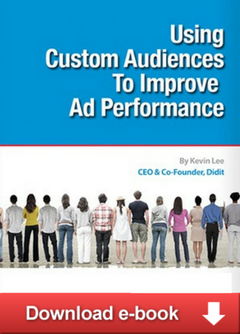
September 9, 2016: We’re big fans of Custom Audiences, a segmentation tactic that lets marketers leverage their first-party data to target and reach relevant audiences on social networks. Currently Facebook (which invented them in 2012) offers them, and so do Twitter, LinkedIn, and Google.
Custom Audiences put a marketer’s hard-earned first-party data to work.
 One of the more interesting ways that you can use Custom Audiences is to create “lookalike” audiences with the same essential characteristics as those of the individuals in your uploaded list, or those who visit your website (Facebook calls these “source audiences.”) The result can be elevated click-through and conversion rates. According to Adobe, using “lookalike” audiences produced a 3X improvement in conversions against ordinary Facebook targeting for one of its advertisers, a finding supported by anecdotal reports from other marketers.
One of the more interesting ways that you can use Custom Audiences is to create “lookalike” audiences with the same essential characteristics as those of the individuals in your uploaded list, or those who visit your website (Facebook calls these “source audiences.”) The result can be elevated click-through and conversion rates. According to Adobe, using “lookalike” audiences produced a 3X improvement in conversions against ordinary Facebook targeting for one of its advertisers, a finding supported by anecdotal reports from other marketers.
This week, Facebook announced that it was extending Lookalike Audiences internationally to 31 nations beyond the U.S. This will make it very easy for e-commerce marketers to quickly ramp up campaigns using their existing customer lists. As Facebook notes, “if you have a source audience of 10,000 people from Finland, you can use that to create a Lookalike Audience of similar people in South Africa.”
To encourage more marketers to consider running internationally-based campaigns, Facebook also published a “Cross Border Business Handbook” with specific consumer insights from Australia, Brazil, Canada, France, Germany, Malaysia, the Philippines, and the UK, plus basic best practices on how its ad units work. It’s also offering a series of webinars on international marketing.
Are you experimenting with Custom Audiences? You really should, because they’re such an efficient way to target, retarget, and “clone” audiences whose characteristics you already know. If you’re unsure how to begin, Didit has a handy e-book, Using Custom Audiences to Improve Ad Performance, that will get you up to speed in no time. You can download this free e-book here:
- 10 Mistakes to Avoid When Using QR Codes for Marketing - September 20, 2023
- Kevin Lee on How AI Changes the SEO Landscape - August 31, 2023
- The Power of Compound Marketing: Kevin Lee Presents @ 1MediaWorld 2023 Global Conference - March 7, 2023

